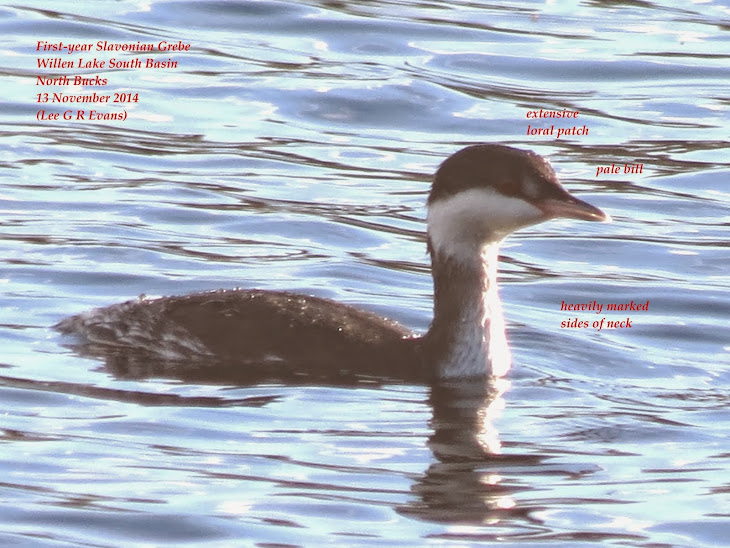TUESDAY 3 FEBRUARY 2009After a light frost, the daylight sunshine started to melt some of the heaviest snow to fall in the region for 18 years. In fact, temperatures soon reached 5 degrees and the thaw was set in motion. I had decided to do my February local bird survey but this was soon put on hold when Simon rang to say that Rob N had located several White-fronted Geese in North Bucks..........
CHESFIELD CLOSE, LITTLE CHALFONT
Up to 5
BRAMBLING have been visiting gardens on this road since the New Year but after 30 minutes of searching, I failed to locate any. A single
FIELDFARE was feeding in one garden, with 5 Greenfinches, 11 Chaffinches,several House Sparrows, 4 Great Tits and 10 Blue Tits.
CHESHAM FISHING LAKES AND BOIS MILL LAKELargely frozen with open water holding 10 Northern Pochard, 3 drake Tufted Duck and 23 Coots, with 21 Black-headed Gulls and a single adult Common Gull standing on the ice.
Adjacent to Hill Farm Road, 17 Jackdaws were present on the chimney stacks. Nearby, 35 Rook nests were located in the wood above Ivy House Farm.
Bois Mill Lake held 5 Mute Swans (adult pair and three young)
LATIMER HALL AND GREAT WATER
The trees surrounding the hall held 23
REDWING, 3 Goldcrests and a Nuthatch, whilst Great Water (largely frozen) was surprisingly devoid of ducks and produced just 11 Mute Swans (2 first-winters) and 31 Coot. Roosting gulls on ice included 89 Black-headed and unusually for this location 7
COMMON GULLS (including 1 first-winter).
NORTH BUCKINGHAMSHIREI was just about to embark on Shardeloes when I took a call from Simon Nichols informing me of 4 Eurasian White-fronted Geese that Rob Norris had located at Gayhurst Motorway Pit. Although they had all flown off, two had returned and were still present. I contacted Rob and he was still watching them and waiting for Paul Moon to arrive. Despite taking me the best part of an hour to drive, I decided to give it a go.
Typically, just as I was passing Luton, Rob texted to say that both birds had flown off in the direction of Linford and the Ouse Valley.
Knowing that Rob was still in the Gayhurst area, I decided to check the valley from the north but despite stopping and searching at all favourable viewpoints, I failed to find any more than 2 Greylag Geese. I did note however where these two birds were heading and returned to this area later.
LINFORD NR (1330-1415 hours)
Most of Linford NR was frozen but boy was there some wildfowl present on what remained.
A remarkable
11 NORTHERN PINTAILS was present (including 6 adult drakes) as well as 518 Eurasian Wigeon, 119 Northern Pochard, 135 Common Teal and 10 Gadwall. There were also 86 Lapwing and 3 different Eurasian Sparrowhawks were patrolling the valley.
GAYHURST QUARRY PITS
Both Nick and Paul had departed the area but with Rob reporting small flocks of Greylag flying back to the grain, I decided to have another look. Some 35 Greylag Geese had returned but there was no sign of the rest of the flock, whilst Mute Swans were numbering 89.
Three
GOOSANDERS flew in, including two adult drakes.
Thanks to Simon, Rob N and Paul Moon, I was able to learn of other locations where Greylag Geese have been seen in the valley and started to search these one by one. I was mostly intrigued by the two birds that I had seen earlier disappear towards Newport Pagnell M1 Services and investigated further.
DOVECOT PIT, NEWPORT PAGNELLAfter painstakingly checking every field, I eventually pin-pointed a huge flock of Greylag Geese residing SE of Dovecot Pit at cSP 853 441. Unfortunately, many of the 500 or more birds were hidden over the ridge and after locating a single BARNACLE GOOSE (which quickly disappeared) and phoning Simon of the flock, I made an attempt to get much closer to the flock. I discovered a footpath by Portfields Farm and this took me to the flock and I was able to gently nudge them towards the ridge. Whilst in the process, Simon then rings to say that the
EURASIAN WHITE-FRONTED GEESE are in view and where am I. Typical !
I made a frantic dash back to the roadside viewpoint opposite the Newport Pagnell Services entrance at SP 856 435 where from 1620-1650, a total of
17 EURASIAN WHITE-FRONTED GEESE was identified and Simon located a single
PINK-FOOTED GOOSE.
The White-fronted Geese were well scattered within the Greylags (which numbered
597, incidentally) but included three first-winters.
I was not able to accurately age the Pink-footed Goose so whether or not it is the long-staying adult of unknown origin is unknown. What I believed to be this bird was present in Northampton recently (at Clifford Hill GP).
BROUGHTON GROUNDS
Thanks to Paul and Rob N, I was able to finally add
GREY PARTRIDGE to my 2009 Bucks Year List - a fabulous covey of NINE birds in a snow-covered field 100 yards behind the pond at SP 912 403.
Nearby, just as it was getting dark, at least 800
COMMON STARLINGS were flighting to roost on the DHL warehouse at the A5130/A509 roundabout at SP 890 404.












